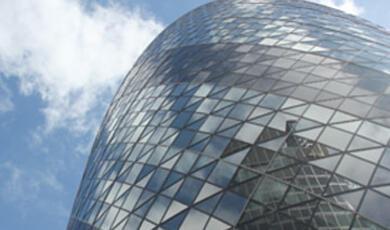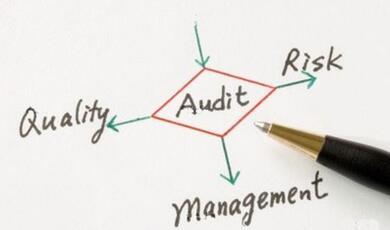How the Financial System Works
Share
- Details
- Text
- Audio
- Downloads
- Extra Reading
This lecture will explore our financial system. Why do banks exist, and what do they do with the money that savers lend to them?
We’ll explore what risks they face and how they can go bust – even if they make completely safe investments. How does the stock market work – what happens when you trade shares, and why do some companies raise money on the stock market and others don’t? Can ordinary citizens influence how the money they save is used?
Download Text
1. How Banks Work
Introduction
A bank can be thought of a shop that sells money. A clothes shop buys clothes from a supplier (let’s say 100 items at £5 each) and sells it to customers (let’s say 100 items at £9 each).
The difference of £4 helps cover two activities that the shop undertakes:
- Operation: running the stores.
- Screening suppliers to ensure that only good clothes are sold in the shop.
A bank borrows money from depositors – citizens who save their money in a bank account (see Lecture 1, How to Save and Invest) – let’s say £100 at a 5% interest rate. It then lends this money to borrowers – let’s say £100 at a 9% interest rate.
The difference of 4% helps cover three activities that the bank undertakes:
- Operation: running the bank branches.
- Screening. Unlike for the shop, the bank screens borrowers (customers) rather than depositors (suppliers).
- Monitoring. For the shop, once the customer has bought the item, the transaction ends there. For the bank, it continues to monitor the borrowers to ensure they repay.
How Banks Create Money
The main risk the bank takes is that borrowers may default – they don’t pay back the £100. The bank may still be able to recover some of the loan. Many loans are secured – to take out the loan, the borrower must pledge some security (also known as collateral) that the lender may seize upon default. If you lend from a pawnbroker, you give them a watch or some jewellery which they keep if you don’t repay. A mortgage is a loan from a bank that’s secured on a house – if the borrower defaults, the bank is entitled to seize the house. However, even if the loan is secured on a house worth £100, the bank may not be able to recover the £100 that it lent. It might need to sell the house quickly (known as a fire sale), in case depositors want to withdraw their money. If it can only sell the house for £90, the loss of £10 is known as the liquidity discount – the discount that the bank must accept in order to liquidate its assets early.
Thus, unlike shops, which hope to sell all the goods they buy from their suppliers, banks don’t. They hold a fraction of their deposits in reserve in case their borrowers default. If they have £100 of deposits, they may hold £10 (10%) in reserve and only lend out £90. This is known as fractional reserve banking. Banks are overseen by a regulator who sets the minimum reserve ratio that they have to retain, to reduce the risk that the bank goes bankrupt. (In the UK, this regulator is the Prudential Regulation Authority). However, banks can always choose to keep more in reserve than they need to.
In the above example, the reserve ratio is 10%. Let’s assume the bank lends out the entire £90 to one borrower, Borrower A.
Borrower A uses the £90 to hire a private tutor for her children. The tutor receives the £90 and deposits it into the bank.[1]
But now the bank can lend out 90% of the £90 that it’s received - £81 – to a new borrower, B.
And the cycle can keep continuing forever:
Stage Deposited Lent Reserves
1 100 90 10
2 90 81 9
3 81 72.9 8.1
4 72.9 65.6 7.3
5 65.6 59.0 6.6
… to ∞
Total 1,000 900 100
Because the money that banks lend gets redeposited, allowing the bank to lend more money, the bank is said to “create” money. Eventually, the bank can create £1,000 of money from the initial £100 received, which corresponds to a money multiplier of 10. The money multiplier is how much money a bank can create from an initial deposit of £1, and is 1 divided by the reserve ratio. (In this case, it’s 1/10% = 10.)
Note that the bank has not “made” 10 times the initial deposit. Its net position is still zero – it owes £1,000 to depositors, it’s owed £900 by borrowers, and it’s kept £100 in reserve. It only makes money from the difference in the interest rate it receives from borrowers and pays to depositors, not from the process of creating money.
The Risks Banks Face
Still, it seems that there is easy money to be made. A bank simply offers a low interest rate to its depositors, charges a high interest rate to its borrowers, and makes money on the “spread” between the two rates. All you needs to do is to screen and monitor your borrowers to ensure they pay you back. As my Economics schoolteacher said, “you’d have to be pretty stupid not to be able to make money as a banker” (which prompted my classmate to whisper to me “Alex, even you could become a banker”). But there’s a catch:
- Depositors typically lend short-term – many bank accounts allow you to withdraw your money at any time. That’s because they’d like the freedom to access their money if they happen to need it.[2]
- Borrowers typically borrow long-term, because they need a long time for them to pay back the loan.
- Homeowners take out 25-year mortgages because the mortgage is much higher than their annual income, after subtracting taxes, living expenses etc.
- Companies borrow to fund research into a new product, but it may take several years for the product to be developed, approved by regulators, marketed, and put on the shelves.
Overall, the bank borrows short-term and lends long-term. This is known as liquidity transformation – transforming short-term deposits into long-term loans – and is shown in the table below:
Stage Deposited Lent Reserves
Total. 1,000. 900. 100
Short-Term. Long-Term
But there’s a problem if depositors wish to withdraw more than the £100 of reserves the bank holds. The bank can’t force its borrowers to repay – if they’ve taken out a 25-year mortgage, they don’t need to fully repay the mortgage until 25 years are up. The bank will try to sell its loans to someone else, but will have to accept a liquidity discount. If the liquidity discount is 50%, the bank can only sell its loans for £450. Taking into account its £100 of reserves, this means that withdrawals of more than £550 will lead to the bank being insolvent. Insolvency is when a company is unable to meet its financial obligations (in this case, the bank can’t meet its obligation to allow depositors to withdraw their money on demand).
Importantly, a bank can become insolvent even if all its loans are safe. Even if it’s screened its borrowers perfectly, and all of them will be able to pay back their loans by the maturity date, the bank can still become insolvent if depositors want to withdraw too much before the loans mature.
Of course, the bank hopes that depositors won’t wish to withdraw more than £100. Normally, it’s individual random events that cause a depositor to withdraw. One decides to start her own business, another’s car got into an accident, a third’s child has decided to study at a US private university. These random events aren’t systematic – they don’t hit all depositors at the same time – but idiosyncratic, only hitting one depositor at a particular time (see Lecture 4, How to Measure and Manage Risk, for more detail on the difference between systematic and idiosyncratic risk). Then, it’s unlikely that depositors in aggregate will want to withdraw more than £100.
If depositors think that other depositors won’t want to withdraw more than £100, they believe their deposits are safe, and see no need to withdraw either. This is known as an equilibrium – a situation when everyone is making the best decision, given everybody else’s decision. Here, if everyone else is keeping their money in the bank (except for the odd idiosyncratic shock), it’s fine for you to do so also.
But there’s another equilibrium. What if depositors think that other depositors will withdraw? Then, it’s in your interest to withdraw also. Otherwise, if other investors have already withdrawn at least £100, then the bank has run out of its reserve and may not be able to pay you back the full value of your deposit. This is known as a bank run or bank panic, where everybody runs to the bank in a panic to withdraw their money – as we saw in 2007 when queues of customers formed outside Northern Rock branches.
A bank run is also an equilibrium, since everyone is making the best decision, given everybody else’s decision. If everyone else is rushing to withdraw, you should do so too. As a result, insolvencies can be a self-fulfilling prophecy. Even if the bank is actually safe, because all the loans that it’s made are safe, simply thinking that the bank is risky can lead to it going bankrupt.
The possibility of bank runs, even on otherwise safe banks, was discovered in a famous 1983 paper by Douglas Diamond and Philip Dybvig, which some say may win the authors the Nobel Prize in Economics one day.[3] Fortunately, in addition to highlighting the problem, Diamond and Dybvig also proposed a solution – deposit insurance. If an agency guarantees to reimburse a customer’s deposits if a bank becomes insolvent, then depositors won’t need to rush to withdraw their money. In the UK, the Financial Services Compensation Scheme guarantees £85,000 of deposits, per person, per bank. It is funded by a levy on banks.
Trading on the Stock Market
A market is a place where many buyers and sellers gather to trade certain items. If you need some vegetables to make dinner, you could go round to your neighbours, offering to buy any spare vegetables from them. But, this will be a time-consuming, and perhaps ultimately unsuccessful process, since your neighbours might not have the vegetables you need. Instead, if you go to the farmers’ market, you know there’ll be lots of potential sellers who you can buy vegetables from. Similarly, if you’re a farmer and you want to sell your produce, doing so at the market is better than knocking on random households’ doors. Markets provide liquidity – the ability to buy and sell a good easily. Without liquidity, you’ll have to suffer a liquidity discount if you want to sell – a random household might only be willing to pay a low price for a farmer’s vegetables since it doesn’t really need them.
The stock market is a market where people buy and sell stocks. If you want to buy shares in Tesco, you could go to your neighbour and ask if she has Tesco shares that she’s willing to sell; this is known as an over-the-counter trade. However, it’s much more efficient to trade on the stock market. In such a market:
- Sellers post an ask price or offer price, which is the minimum they’re willing to sell for.
- Buyers post a bid price, which is the maximum they’re willing to pay.
A trade is made whenever a buyer accepts the ask or a seller accepts the bid. Previously, these acceptances were communicated by hand signals on the trading floor, known as an open outcry market. This was abolished in the UK in 1986 as part of the “Big Bang” deregulation; nowadays, trading takes place electronically.
At a farmers’ market, you’re either a buyer or a seller. In the stock market, there are market makers who are both buyers and sellers. They quote two-sided markets – both a bid price at which they’re willing to buy and an ask price at which they’re willing to sell, like a spread betting site where you can bet on either sports team to win. For example, they may be willing to buy 1 share of Tesco for 225p and sell 1 share of Tesco for 226p. They make a profit on the bid-ask spread, the difference between the bid and ask price (1p in the above example) – again like a spread betting site. Examples of market makers include Peel Hunt and Canaccord Genuity. There are many market makers for the same stock, so what you’ll see quoted on a financial website are best prices – the lowest ask price and highest bid price across market makers.
How do you or I get access to market makers? Through brokers, such as Hargreaves Lansdown, in return for a commission (either a fixed fee, or a percentage of the value of the shares that you trade). You can place two types of orders:
- A market order is an instruction to trade at the current market price, i.e. buy at the current ask or sell at the current bid.
- A limit order is an instruction to trade only if the price crosses a given threshold.
- A limit sell order gives the minimum price at which you’re willing to sell. If the bid price rises to this limit, your order will go through. In the above example, with a bid price of 225p, you can already sell to the market maker for 225p. So, it will only make sense to place a limit sell order if your limit price is above 225p.
- A limit buy order gives the maximum price at which you’re willing to buy. If the ask price falls to this limit, your order will go through. In the above example, with an ask price of 226p, you can already buy from the market maker for 226p. So, it will only make sense to place a limit buy order if your limit price is below 226p.
After you buy a share, most brokers will hold shares in a nominee account (such as Hargreaves Lansdown Nominees). The broker holds the shares on your behalf – it’s the legal owner, but you’re the real owner and retain ultimate rights. You receive all future dividends, and also have the right to vote at Annual General Meetings (AGMs) – see Lecture 1, How to Save and Invest, for what owning shares entitle you to.
Nominee accounts are used for simplicity – it means that the company’s shareholder register only needs to display the nominee account, rather than each individual shareholder. It also means that, if you sell your shares to another client of the same broker, the shareholder register is unchanged; the nominee simply passes future dividends to the new owner rather than you.
Listing on the Stock Market
The farmers’ market is a generic name for a market where farmers sell their produce, but there are specific farmers’ markets such as the Marylebone Farmers’ Market. Similarly, the stock market is a generic name for the “place” where investors trade stocks, but there are specific stock exchanges such as the London Stock Exchange and the New York Stock Exchange.
On a stock exchange, you can only trade stocks that are listed on that exchange. For its shares to be listed, a company needs to pay fees to the stock exchange and comply with its listing rules. These are rules that the exchange sets (e.g. on the disclosure of executive pay) to protect investors. Different exchanges may have different standards; even within one exchange, there may be more than one set of standards. Within the London Stock Exchange, companies on the Premium List need to comply with the UK Corporate Governance Code (e.g. for over 50% of your board of directors to be independent) or explain why they are not doing so, but those on the Main List don’t. The Alternative Investment Market is another UK stock exchange with less stringent rules than the London Stock Exchange.
Why do companies want to list in the stock market? The simple answer is to raise money. But that can’t be the full picture since the stock market isn’t the only way to raise money. Start-up companies don’t raise money on the stock market, as they’re not established enough to comply with the listing rules. Instead, they raise debt from a bank, and equity from private investors such as the founders, angel investors (individual wealthy people who finance start-ups), and venture capitalists (funds that finance start-ups). (See Lecture 6, How to Finance a Company, for how companies choose between raising money from debt vs. equity). This is known as seed funding.
If the start-up is successful, it will want to raise more financing to allow it to grow. But it still won’t yet raise money from the stock market; instead, it will raise Series A funding – a second stage of financing beyond the initial seed round that often involves millions of pounds. The initial seed investors will be invited to participate, but many new investors are also brought in (often other venture capital firms). The enterprise may have further funding rounds, known as Series B, Series C, and so on.
There are two reasons why a company wishes to list:
- To raise even more money. Once the company has raised as much as it can from venture capitalists, it needs other funding sources. A listed company’s shares can be bought by anyone on the stock market, which is why listing is known as going public. The company undertakes an Initial Public Offering (IPO), where new shares are created and sold to the public. These new shares are known as primary equity since any investor buying them is purchasing newly-created shares. This contrasts with secondary equity bought second-hand from another investor.
- In addition, listing allows a company to raise new equity from the public in the future. A Seasoned Equity Offering (SEO) is when an already-public company raises more equity.
- Existing investors wish to cash out. Listing creates a secondary market for existing investors to sell their second-hand shares. In a Direct Listing, no new shares are created; only existing shares are sold. Spotify and Slack are recent examples of direct listings.
Many listings involve both the issuance of new primary equity and the sale of existing secondary equity. Both types of shares are equally good as each other – each entitle the owner to the same dividends and the same votes – and so they will trade at the same price.
© Professor Edmans, 2021
Some of this summary is adapted from Principles of Corporate Finance by Richard Brealey, Stewart Myers, Franklin Allen, and Alex Edmans (14th edition, 2022). For brevity, this is only a partial summary of the lecture. Please see the full lecture for how mutual funds and pension funds work.
[1] More realistically, the tutor might have some expenses (e.g. travel to teach the family), and spend some of his money on food or pay taxes. However, all of this money will eventually get deposited in a bank.
[2] While some accounts (often known as “fixed rate bonds”, even though they’re not strictly a bond as we defined in Lecture 1) do lock up your money, in return for a higher interest rate, they still only lock it up for a couple of years.
[3] Diamond, Douglas W. and Philip H. Dybvig (1983): “Bank Runs, Deposit Insurance, and Liquidity”. Journal of Political Economy 91, 401-419.
Some of this summary is adapted from Principles of Corporate Finance by Richard Brealey, Stewart Myers, Franklin Allen, and Alex Edmans (14th edition, 2022). For brevity, this is only a partial summary of the lecture. Please see the full lecture for how mutual funds and pension funds work.
[1] More realistically, the tutor might have some expenses (e.g. travel to teach the family), and spend some of his money on food or pay taxes. However, all of this money will eventually get deposited in a bank.
[2] While some accounts (often known as “fixed rate bonds”, even though they’re not strictly a bond as we defined in Lecture 1) do lock up your money, in return for a higher interest rate, they still only lock it up for a couple of years.
[3] Diamond, Douglas W. and Philip H. Dybvig (1983): “Bank Runs, Deposit Insurance, and Liquidity”. Journal of Political Economy 91, 401-419.
Part of:
This event was on Tue, 26 Oct 2021
Support Gresham
Gresham College has offered an outstanding education to the public free of charge for over 400 years. Today, Gresham College plays an important role in fostering a love of learning and a greater understanding of ourselves and the world around us. Your donation will help to widen our reach and to broaden our audience, allowing more people to benefit from a high-quality education from some of the brightest minds.


 Login
Login







